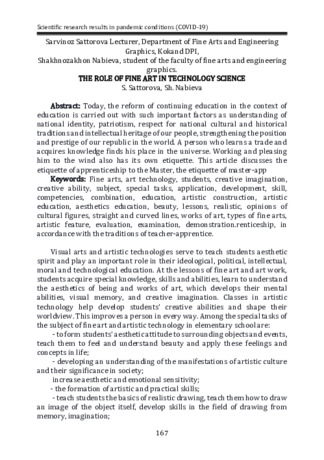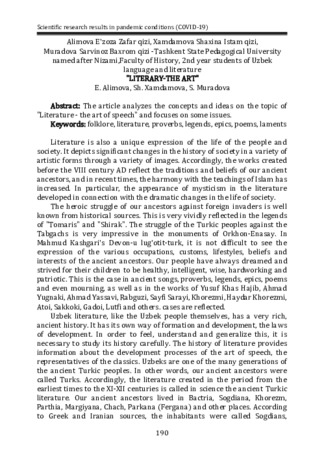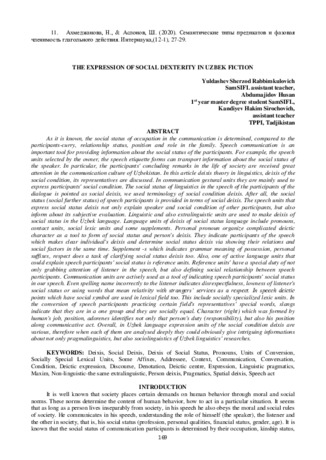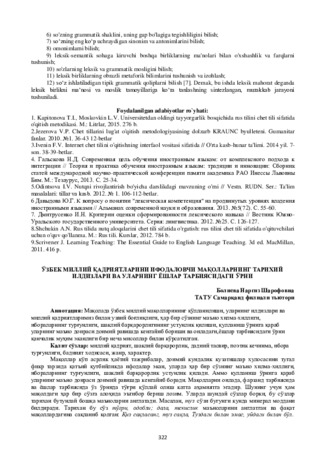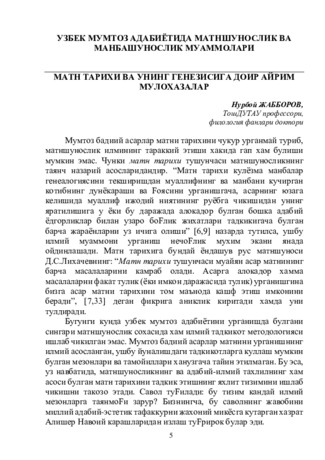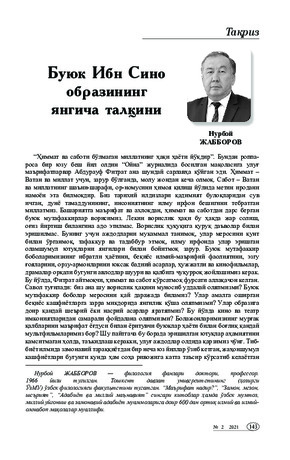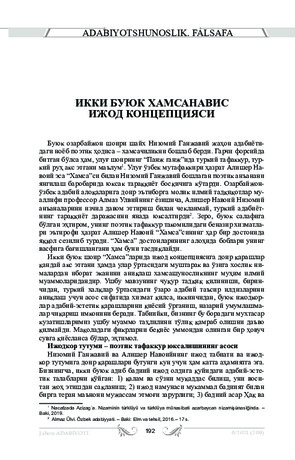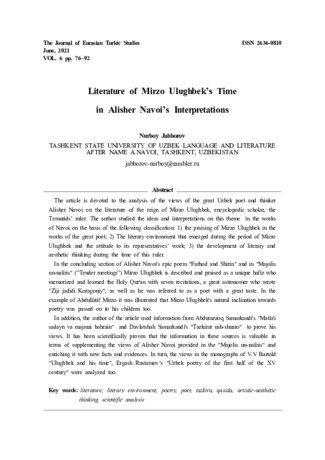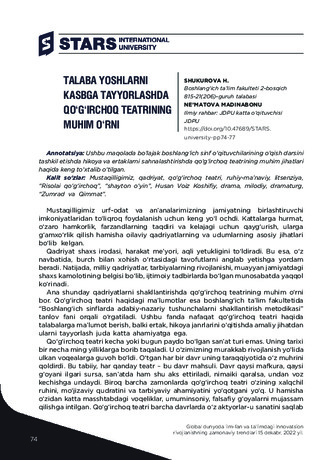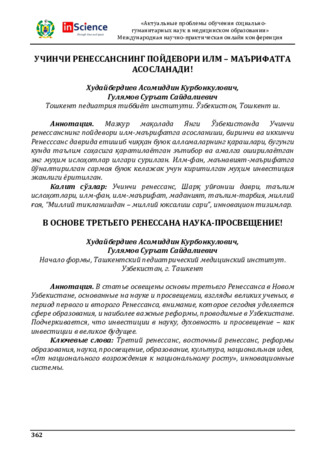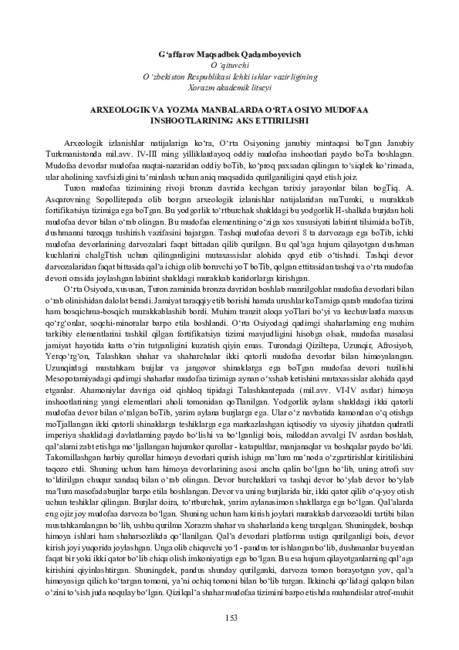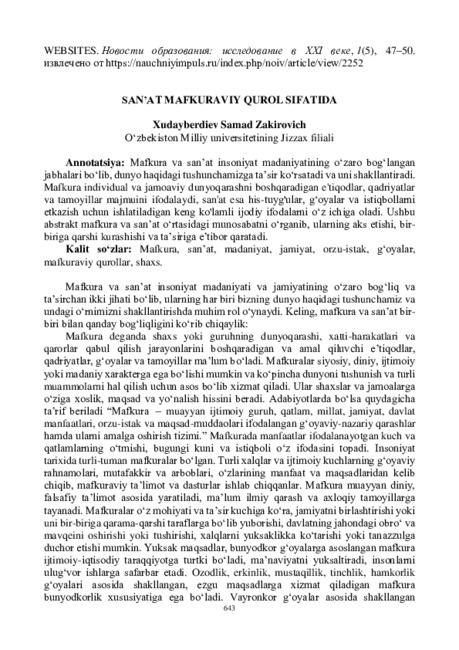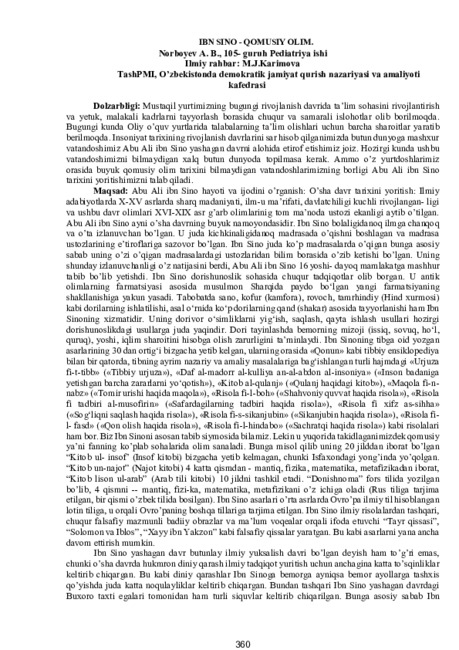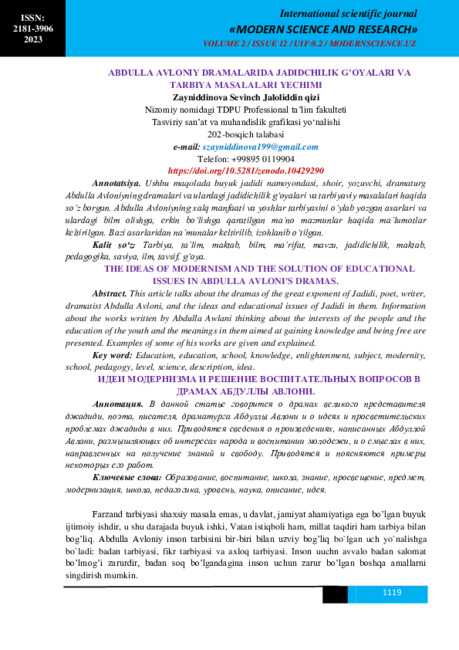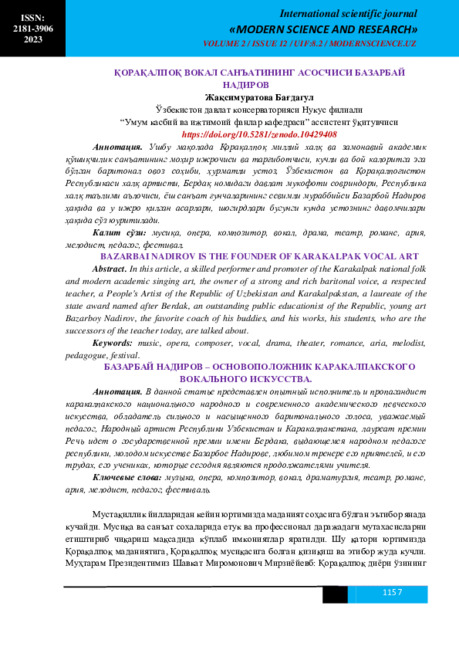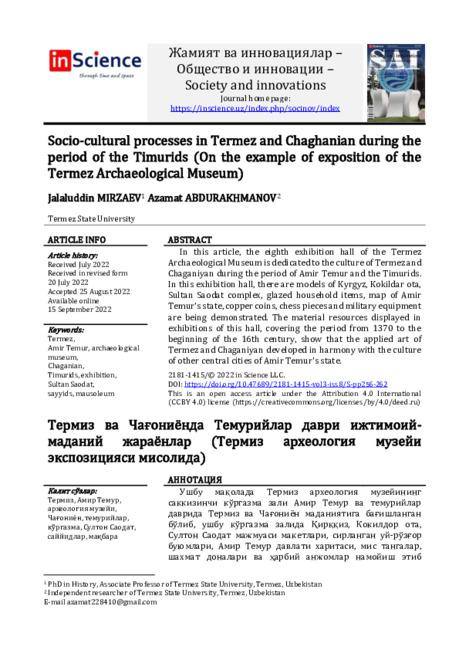All articles - Art
-
The role of fine art in technology scienceToday, the reform of continuing education in the context of education is carried out with such important factors as understanding of national identity, patriotism, respect for national cultural and historical traditions and intellectual heritage of our people, strengthening the position and prestige of our republic in the world. A person who learns a trade and acquires knowledge finds his place in the universe. Working and pleasing him to the wind also has its own etiquette. This article discusses the etiquette of apprenticeship to the Master, the etiquette of master-app
Scientific research results in pandemic conditions (COVID-19) -
The article analyzes the concepts and ideas on the topic of "Literature - the art of speech" and focuses on some issues
-
Creativity of pavl petrovich benkov as duration of Uzbekistan's paintingIn this article, the author analyzes the compositions of the outstanding artist and teacher of Uzbekistan, the first half of the 20th century, Pavel Petrovich Benkov. A brief historical and historiographical review examines his life path and the trajectory of his work in the 1920s and 1930s. XX century
Scientific research results in pandemic conditions (COVID-19) -
The expression of social dexterity in Uzbek fiction
Analysis of current problems, innovations, traditions, solutions and fiction in teaching foreign languagesAs it is known, the social status of occupation in the communication is determined, compared to the
participants-curry, relationship status, position and role in the family. Speech communication is an important tool for providing information about the social status of the participants. For example, the speech units selected by the owner, the speech etiquette forms can transport information about the social status of the speaker. In particular, the participants' concluding remarks in the life of society are received great attention in the communication culture of Uzbekistan. In this article deixis theory in linguistics, deixis of the social condition, its representatives are discussed. In communication gestural units they are mainly used to express participants' social condition. The social status of linguistics in the speech of the participants of the dialogue is pointed as social deixis, we used terminology of social condition deixis. After all, the social status (social further status) of speech participants is provided in terms of social deixis. The speech units that
express social status deixis not only explain speaker and social condition of other participants, but also inform about its subjective evaluation. Linguistic and also extralinguistic units are used to make deixis of social status in the Uzbek language. Language units of deixis of social status language include pronouns, contact units, social lexic units and some supplements. Personal pronoun organize complicated deictic character as a tool to form of social status and person's deixis. They indicate participants of the speech which makes clear individual's deixis and determine social status deixis via showing their relations and
social factors in the same time. Supplement -s which indicates grammar meaning of possession, personal
suffixes, respect does a task of clarifying social status deixis too. Also, one of active language units that could explain speech participants' social status is reference units. Reference units' have a special duty of not only grabbing attention of listener in the speech, but also defining social relationship between speech participants. Communication units are actively used as a tool of indicating speech participants' social status in our speech. Even spelling name incorrectly to the listener indicates disrespectfulness, lowness of listener's social status or using words that mean relativity with strangers’ services as a respect. In speech deictic points which have social symbol are used in lexical field too. This include socially specialized lexic units. In
the conversion of speech participants practicing certain field's representatives' special words, slangs indicate that they are in a one group and they are socially equal. Character (right) which was formed by human's job, position, adorenes identifies not only that person's duty (responsibility), but also his position along communicative act. Overall, in Uzbek language expression units of the social condition deixis are various, therefore when each of them are analysed deeply they could obviously give intriguing informations about not only pragmalinguistics, but also sociolinguistics of Uzbek linguistics' researches -
Ўзбек миллий қадриятларини ифодаловчи мақолларнинг тарихий илдизлари ва уларнинг ёшлар тарбиясидаги ўрни
Analysis of current problems, innovations, traditions, solutions and fiction in teaching foreign languagesМақолада ўзбек миллий мақолларининг қўлланилиши, уларнинг илдизлари ва миллий қадриятларимиз билан узвий боғлиқлиги, ҳар бир сўзнинг маъно хилма-хиллиги, ибораларнинг турғунлиги, шаклий барқарорлигининг устунлик қилиши, қулланиш ўрнига қараб уларнинг маъно доираси доимий равишда кенгайиб бориши ва оиладаги,ёшлар тарбиясидаги ўрни қанчалик муҳим эканлиги бир неча мисоллар билан кўрсатилган
-
Dunyo bo'yicha maxsus bayramlar
Analysis of current problems, innovations, traditions, solutions and fiction in teaching foreign languagesUshbu maqola" Special holidays around the world "deb nomlanadi. Bu o'zbek tilida "Dunyo
mamlakatlarining maxsus bayramlari"deb tarjima qilinadi.Ushbu metodik qo'llanmada barcha ingliz tili
o'qituvchilari uchun foydalana oladigan interfaol usuldagi metodlardan foydalansa bo'ladi -
Artistic expression of the author's creative concept in "Khamsa" ("Five") by Alisher Navoi
in LibraryOne of the important scientific problems of navigation studies is the study of the justification of how views are reflected regarding the creative concept and on what artistic and aesthetic criteria they are justified in the “Khamsa” of the great poet and thinker Alisher Navoi. The study of this scientific problem, firstly, is the basis for determining the origins of the worldview of the great poet, and secondly, it allows a deeper study of the literary and aesthetic views of the great thinker, to make theoretical generalizations. Naturally, our brief observations on this subject do not pretend to fully cover the analysis of the problem. We will try to highlight some important aspects of this issue.
-
Without a deep study of the history of the text of classical works of art, it is impossible to talk about the progress of the science of textology. Because the concept of text history is one of the basic theoretical foundations of textual studies. "The history of the text includes all the processes from the investigation of the genealogy of the manuscript sources to the study of the worldview and ideas of the author and the scribe who copied the source, from the realization of the author's creative intention in the creation of the work to the study of its interrelated aspects with other literary monuments that are related to its creation to one degree or another" [6 ,9], it becomes more clear how important it is to study this scientific problem.
-
"A nation without courage and perseverance has no real life." Exactly one hundred and five years ago, the great enlightener Abdurauf Fitrat gave such a title to his article published in "Oyna" magazine. Courage - to sacrifice one's life for the sake of the country and the nation, if necessary. Sabot - is to be able to show the will to protect the honor and dignity of the country and the nation. We are a nation whose historical roots drank water from ancient springs, rocked the cradle of world civilization and humanity. We are the heirs of great thinkers who taught humanity about enlightenment and morality, courage and endurance. But the right of inheritance cannot be paid just by talking about it. The right of succession cannot be achieved by empty claims. For this, it is necessary to know the ancestors perfectly, to diligently study their heritage, to think and think, to enrich the universal achievements they have achieved in science and knowledge with new ones.
-
The great Azerbaijani poet Sheikh Nizami Ganjavi started a unique poetic phenomenon in world literature - khamsalik. Although it was written in Persian, it is known that the great poet's "Panj Ganj" reflects the Turkish thought and the Turkish spirit. The great Uzbek thinker Hazrat Alisher Navoi brought the poetic tradition started by Nizami Ganjavi to a high stage of development with his "Khamsa". According to Professor Almaz Ulviy, the author of remarkable scientific studies on Azerbaijani-Uzbek literary relations, Alisher Navoi did not limit himself to the consistent continuation of Nizami's traditions, but also raised the level of development of Turkish literature. After all, the respect for his great predecessor, the recognition of his unique services in the development of poetic thinking is clearly felt in every epic of Hazrat Alisher Navoi's "Khamsa". This is also confirmed by the fact that separate chapters of "Khamsa" epics are dedicated to him.
-
The article is devoted to the analysis of the views of the great Uzbek poet and thinker
Alisher Navoi on the literature of the reign of Mirzo Ulughbek, encyclopedic scholar, the Temurids’ ruler. The author studied the ideas and interpretations on this theme in the works of Navoi on the basis of the following classification: 1) the praising of Mirzo Ulughbek in the works of the great poet; 2) The literary environment that emerged during the period of Mirzo Ulughbek and the attitude to its representatives’ work; 3) the development of literary and aesthetic thinking during the time of this ruler.
In the concluding section of Alisher Navoi's epic poem "Farhod and Shirin" and in "Majolis un-nafois" (“Tender meetings”) Mirzo Ulughbek is described and praised as a unique hafiz who memorized and learned the Holy Qur'an with seven recitations, a great astronomer who wrote "Ziji jadidi Koragoniy", as well as he was referred to as a poet with a great taste. In the example of Abdullatif Mirzo it was illustrated that Mirzo Ulughbek's natural inclination towards poetry was passed on to his children too.
In addition, the author of the article used information from Abdurazzoq Samarkandi's "Matla'i sadayn va majmai bahrain" and Davlatshah Samarkandi's "Tazkirat ush-shuaro" to prove his views. It has been scientifically proven that the information in these sources is valuable in terms of supplementing the views of Alisher Navoi provided in the "Majolis un-nafois" and enriching it with new facts and evidences. In turn, the views in the monographs of V.V Bartold "Ulughbek and his time", Ergash Rustamov’s "Uzbek poetry of the first half of the XV century" were analyzed too. -
Talaba yoshlarni kasbga tayyorlashda qo‘g‘irchoq teatrining muhim o‘rni
Современные тенденции инновационного развития науки и образования в глобальном миреUshbu maqolada bo‘lajak boshlang‘ich sinf o‘qituvchilarining o‘qish darsini tashkil etishda hikoya va ertaklarni sahnalashtirishda qo‘g‘irchoq teatrining muhim jihatlari haqida keng to‘xtalib o‘tilgan.
-
The basis of the third renaissan is science and enlightenment
Актуальные проблемы обучения социально-гуманитарных наук в медицинском образованииThis article highlights the origins of the Third Renaissance in New Uzbekistan based on knowledge, the views of the great scientists of the first and second Renaissance, the attention paid to the field of education today, and the most important ongoing reforms, outlines the importance of directed investment in science, spirituality and education – as an investment in the great future.
-
Arxeologik va yozma manbalarda o‘rta osiyo mudofaa inshootlarining aks ettirilishi
Global partnership as a condition and guarantee of sustainable developmentArxeologik izlanishlar natijalariga ko'ra, 0‘rta Osiyoning janubiy mintaqasi boTgan Janubiy Turkmanistonda mil.avv. 1V-HI ming yilliklardayoq oddiy mudofaa inshootlari paydo boTa boshlagan. Mudofaa dcvorlar mudofaa nuqtai nazaridan oddiy boTib, ko'proq paxsadan qilingan to'siqdck ko'rinsada, ular aholining xavfsizligini ta'minlash uchun aniq maqsadida qurilganiligini qayd etish joiz.
-
Mafkura va san’at insoniyat madaniyatining o‘zaro bog‘langan jabhalari bo‘lib, dunyo haqidagi tushunchamizga ta’sir ko‘rsatadi va uni shakllantiradi. Mafkura individual va jamoaviy dunyoqarashni boshqaradigan e'tiqodlar, qadriyatlar va tamoyillar majmuini ifodalaydi, san'at esa his-tuyg'ular, g‘oyalar va istiqbollarni etkazish uchun ishlatiladigan keng ko'lamli ijodiy ifodalarni o‘z ichiga oladi. Ushbu abstrakt mafkura va san’at o‘rtasidagi munosabatni o‘rganib, ularning aks etishi, bir-biriga qarshi kurashishi va ta’siriga e’tibor qaratadi.
-
Mustaqil yurtimizning bugungi rivojlanish davrida ta’lim sohasini rivojlantirish va yetuk, malakali kadrlarni tayyorlash borasida chuqur va samarali islohotlar olib borilmoqda. Bugungi kunda Oliy o’quv yurtlarida talabalarning ta’lim olishlari uchun barcha sharoitlar yaratib berilmoqda. Insoniyat tarixining rivojlanish davrlarini sar hisob qilganimizda butun dunyoga mashxur vatandoshimiz Abu Ali ibn Sino yashagan davrni alohida etirof etishimiz joiz. Hozirgi kunda ushbu vatandoshimizni bilmaydigan xalq butun dunyoda topilmasa kerak. Ammo o’z yurtdoshlarimiz orasida buyuk qomusiy olim tarixini bilmaydigan vatandoshlarimizning borligi Abu Ali ibn Sino tarixini yoritishimizni talab qiladi.
-
THE IDEAS OF MODERNISM AND THE SOLUTION OF EDUCATIONAL ISSUES IN ABDULLA AVLONI'S DRAMAS.This article talks about the dramas of the great exponent of Jadidi, poet, writer, dramatist Abdulla Avloni, and the ideas and educational issues of Jadidi in them. Information about the works written by Abdulla Awlani thinking about the interests of the people and the education of the youth and the meanings in them aimed at gaining knowledge and being free are presented. Examples of some of his works are given and explained.
Modern Science and Research -
In this article, a skilled performer and promoter of the Karakalpak national folk and modern academic singing art, the owner of a strong and rich baritonal voice, a respected teacher, a People's Artist of the Republic of Uzbekistan and Karakalpakstan, a laureate of the state award named after Berdak, an outstanding public educationist of the Republic, young art Bazarboy Nadirov, the favorite coach of his buddies, and his works, his students, who are the successors of the teacher today, are talked about.
-
Socio-cultural processes in Termez and Chaghanian during the period of the Timurids (On the example of exposition of the Termez Archaeological Museum)
in LibraryIn this article, the eighth exhibition hall of the Termez Archaeological Museum is dedicated to the culture of Termez and Chaganiyan during the period of Amir Temur and the Timurids. In this exhibition hall, there are models of Kyrgyz, Kokildar ota, Sultan Saodat complex, glazed household items, map of Amir Temur's state, copper coins, chess pieces and military equipment are being demonstrated. The material resources displayed in exhibitions of this hall, covering the period from 1370 to the beginning of the 16th century, show that the applied art of Termez and Chaganiyan developed in harmony with the culture of other central cities of Amir Temur's state.
